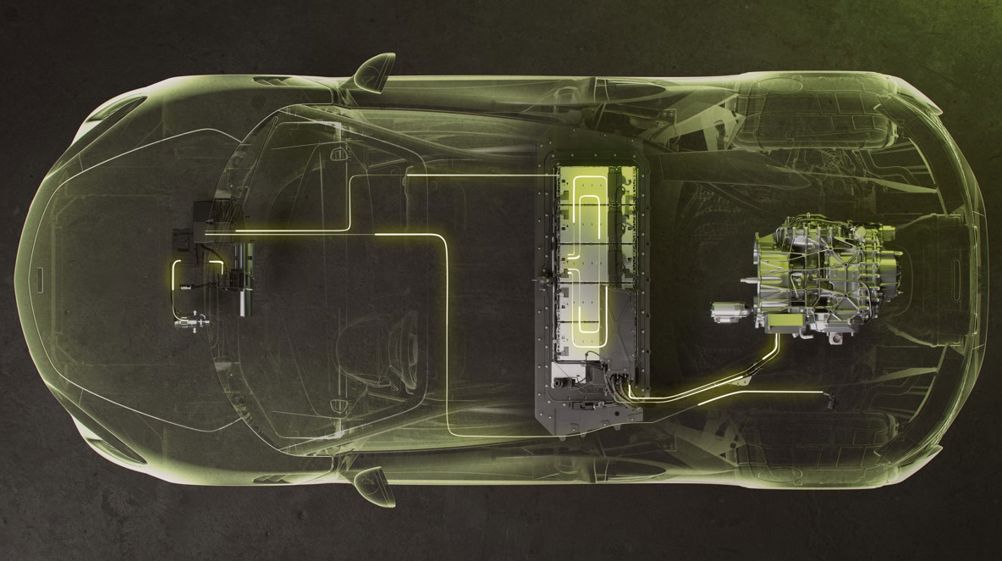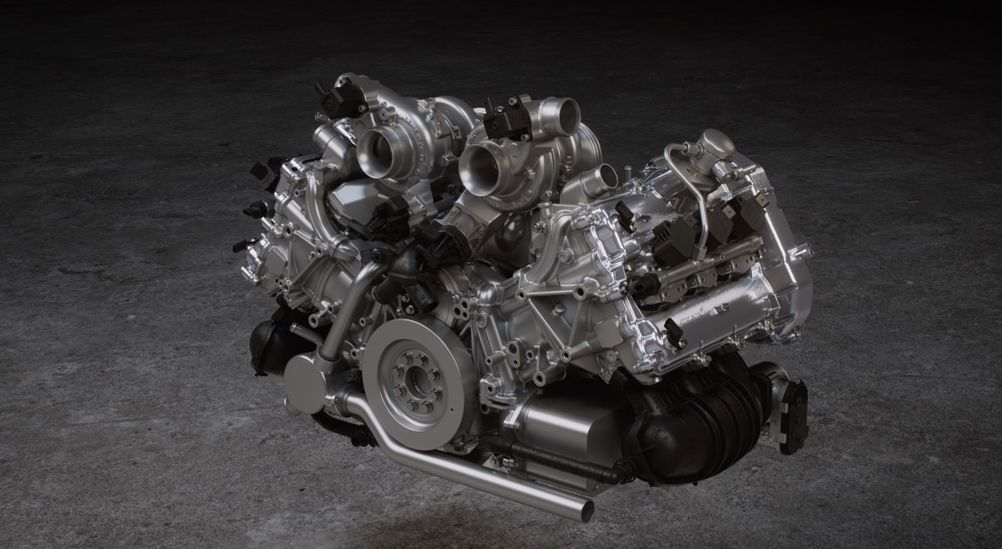The new Artura is a landmark product for McLaren. While the British supercar manufacturer has been working with hybrid powertrains on its limited-edition Ultimate Series cars for over a decade, this is the first time that the technology has been applied to a regular production model.
The Artura also sees the debut of a new twin turbocharged V6 engine, designed in-house by McLaren and produced by Ricardo in Shoreham. Meanwhile, the carbon fibre monocoque is the first complete tub to be manufactured at the new McLaren Composites Technology Centre in Sheffield.
McLaren’s longstanding obsession with composite materials plays a particularly important role in this car. With 7.6kWh of usable capacity, the Artura’s lithium-ion battery is not an especially large one; neither is its 94bhp axial-flux electric motor, which is only slightly bigger than a brake disc and weighs just 15.4kg.
But put the two together with all the accompanying hardware and it’s still a big chunk of additional mass to accommodate on a car that prioritises light weight and driving purity above all else. With that in mind, McLaren has sought to shed every excess gram across the car.
“We’re only ready to enter this segment now because we’ve got the weight down to a level where the dynamic performance can feel like a [non-hybrid] car,” comments McLaren’s chief engineer, Geoff Grose. “It’s also extremely compact. We’ve really fought for every millimetre to produce a car that has a shorter wheelbase than we’ve used before, despite the addition of the electric motor and the battery.”

Compared to McLaren’s previous designs, the central tub uses four new carbon materials, a new resin system and a new structural core material. A highly-automated process combines 500 individual pieces of carbon fibre into 72 pre-forms, making up 11 sub-assemblies. These are fed into a single giant tool and subjected to an RTM-style process that draws resin through the material before it’s cured. Aluminium subframes – lighter and stiffer than those on the previous chassis – hold the powertrain and suspension, as well as providing a deformable crash structure at the front.
Another innovative feature of the new platform is its ethernet-based electrical architecture. Designed to futureproof the platform, with faster communication speeds, greater capacity and the option of OTA updates, it boasts a 10 per cent weight saving and 25 per cent less packaging volume than its predecessor.
“The ethernet system is a massive step,” comments Grose. “We have four domain controllers spread across the car that can host software for any feature or function we might need. That limits the proliferation of additional devices.”
Much of the weight saving also comes from the powertrain. At 160kg, the V6 is some 50kg lighter than the 3.8-litre V8 found in the McLaren 570S, yet it produces 15bhp more at 577bhp. Factor in the hybrid system, and the Artura has a combined maximum output of 671bhp. That, it turns out, is plenty in a car that weighs 1,395kg dry.
On the road
Prod the start button and the Artura comes to life almost silently. It defaults to E-Mode with little more than a faint whine from the inverter as you start to move.
Initial pullaway is reasonably strong, with 225Nm of torque from the electric motor, but this rapidly fades away. Although the Artura can reach up to 80mph in E-Mode and has an all-electric range of around 19 miles, it’s no quicker in this form than a typical family hybrid.
But that’s not really what this powertrain is about. E-mode allows you to glide silently through traffic jams or leave the house without waking up the neighbours in the morning. Mostly, though, the electric motor is there to work with the combustion engine, which it does to stunning effect.
While McLaren’s old V8 had a noticeable swell in torque as the boost built up, the electrically-assisted V6 pulls heroically from any rpm. Like all of the Artura’s actions, it’s a smooth, measured response to your inputs that makes this formidably powerful car feel amazingly exploitable.

Switch to Sport or Track mode and the combustion engine stays on permanently. Track mode also increases the amount of regen (up to 24kW) to keep the battery at its highest possible state of charge.
Unlike most hybrids, this energy is only recuperated on overrun. McLaren looked at employing a brake-by-wire system, but discounted it, Grose explains: “We did some simulation around regen strategy and brake-by-wire. We concluded that it can become quite inconsistent. For instance, if you gear up to take a lot of energy but your battery is full, you won’t be able to use the regen and it will feel different through the pedal. We wanted to ensure consistency, with enough energy storage capacity for prolonged sessions of track driving. The target we set during development was a 10-lap (40-mile) stint on the Nardo handling circuit in Italy.”
Dynamic benefits
The McLaren’s trim weight – only 46kg heavier than the non-hybrid 570S – gives it a staggering power to weight ratio of 481bhp/tonne in its lightest form. It feels explosively fast, pulling with rising urge all the way up to the 8,500rpm redline.
But the greatest benefits of the lightweight construction are felt in the corners. The 570S was among the lightest and most agile members of the old supercar pack, and yet the minimal weight increase is virtually impossible to detect. On the road, the Artura slices into corners with the same absence of inertia.
It feels incredibly stable too. The compact dimensions of the 120-degree V6 not only bring the engine’s centre of gravity height down, but they also allowed McLaren to move from double wishbones to a multi-link rear suspension system. Previous models weren’t exactly wanting in this regard, but the new setup has resulted in far greater toe stiffness, which improves precision. The revised geometry also creates toe-in under braking to maximise stability.
Another McLaren trademark that’s alive and well is the steering feel. While rivals like Porsche and Ferrari have adopted energy-saving electric power steering systems, McLaren has stuck with an electrohydraulic system. It’s slightly calmer than the rather chatty system in the 570S, but the stream of information fed back to your fingertips is still among the best in the business.
“We’re a technology company, and part of our roadmap is to look at technologies like electrically-assisted steering. But steering feel is such an important part of our DNA, and we feel that a hydraulically-controlled system still gives us better feedback,” notes Grose.

This quest for purity is what defines McLaren’s cars – and it’s what makes the Artura such a challenging platform for electrification. But Grose and his team appear to have succeeded in delivering a car that embraces the benefits of hybrid technology without any compromise in dynamics.
Headline figures like 61.5mpg and 104g/km of CO2 are remarkable in a car that’s also capable of more than 200mph. And yet the most impressive thing is how quickly you forget that the Artura is a plug-in hybrid and simply drive it as you would any other lightweight sportscar.
Only when we encounter a pair of horse riders and flick silently back to E-mode does this duality come to the fore. If this is the future for car enthusiasts, it’s looking very bright indeed.











Guest blog: exploring opportunities for hydrogen combustion engines
"We wouldn't need to pillage the environment for the rare metals for batteries, magnets, or catalisers". Batteries don't use rare...